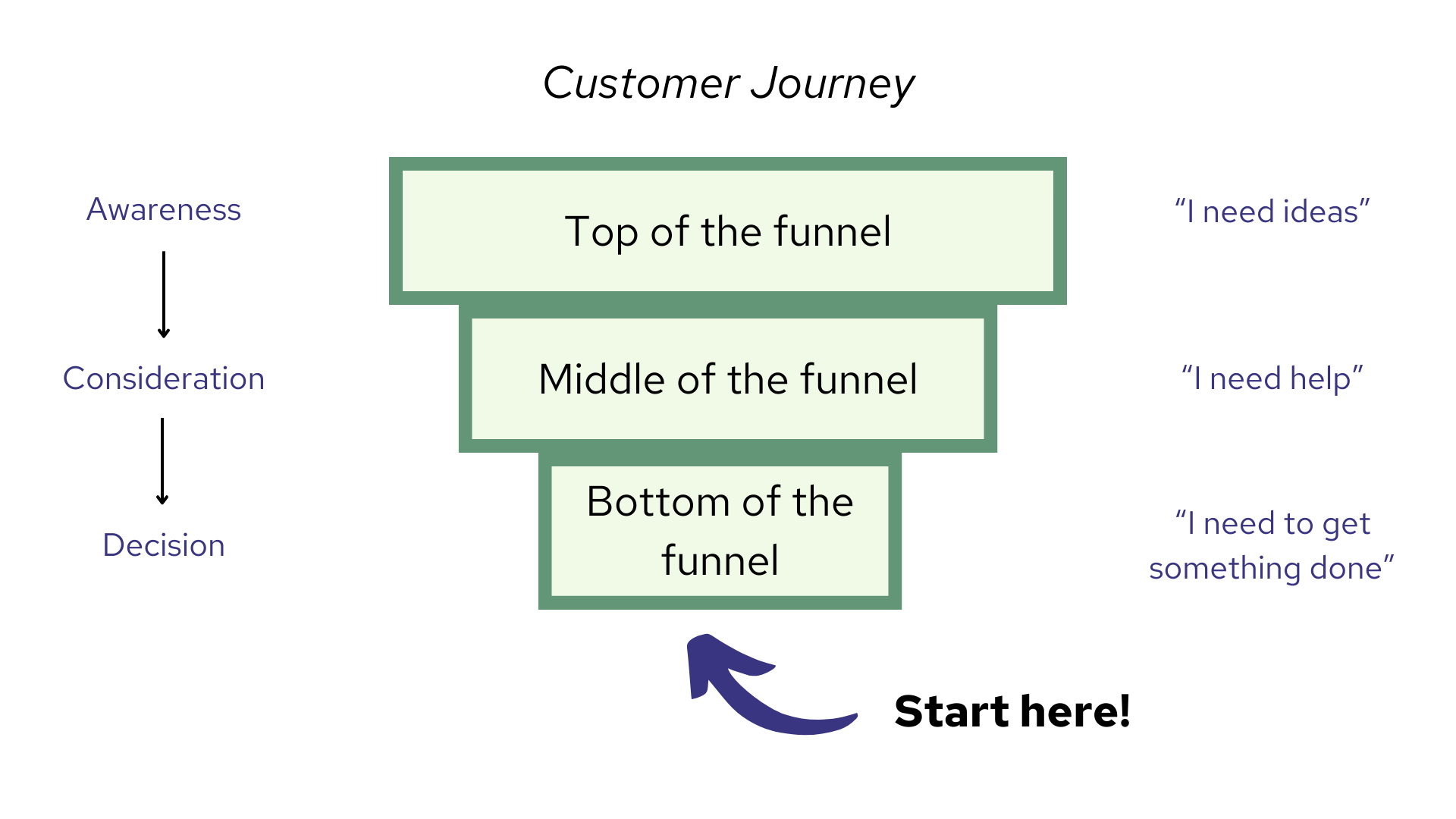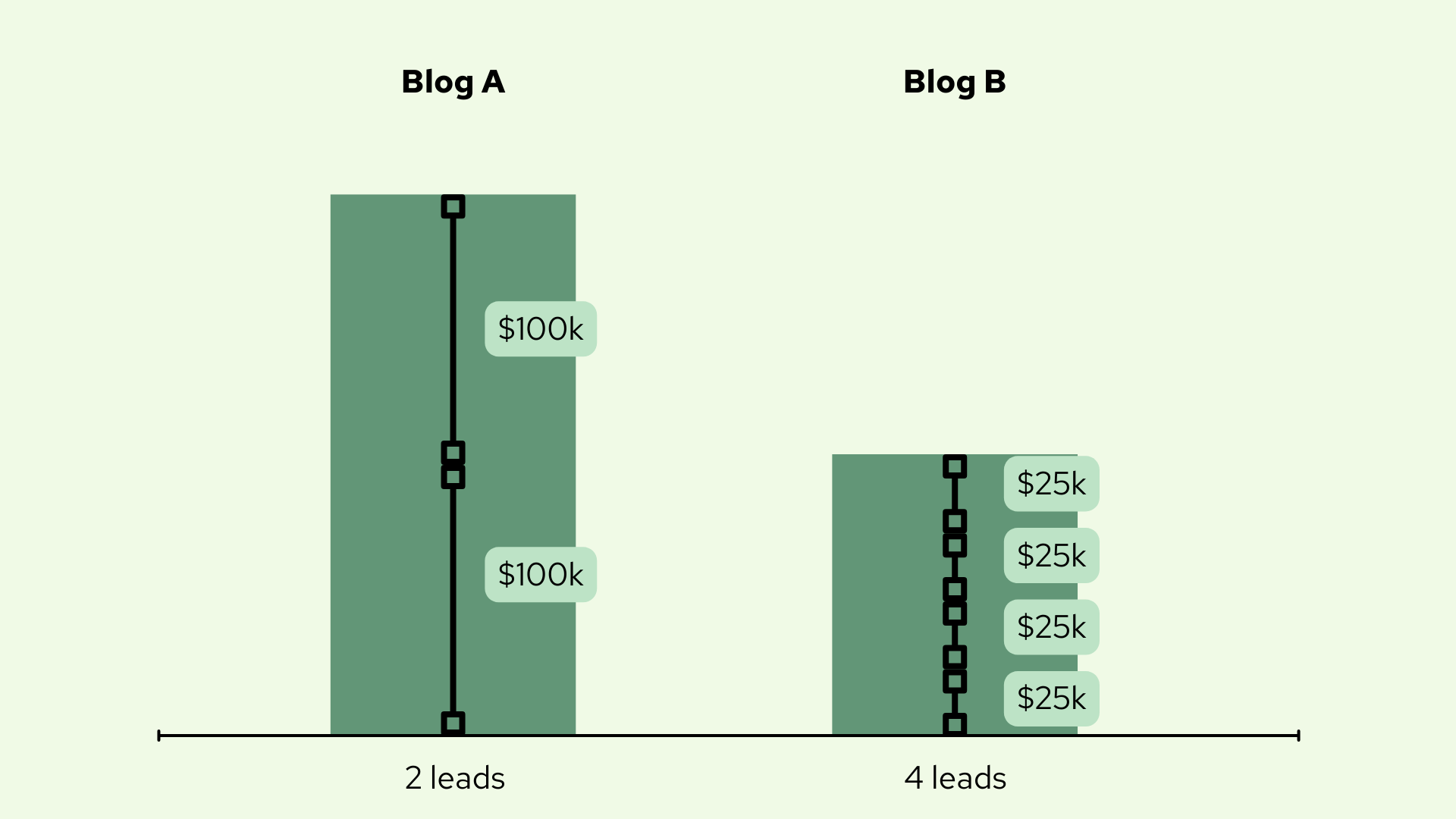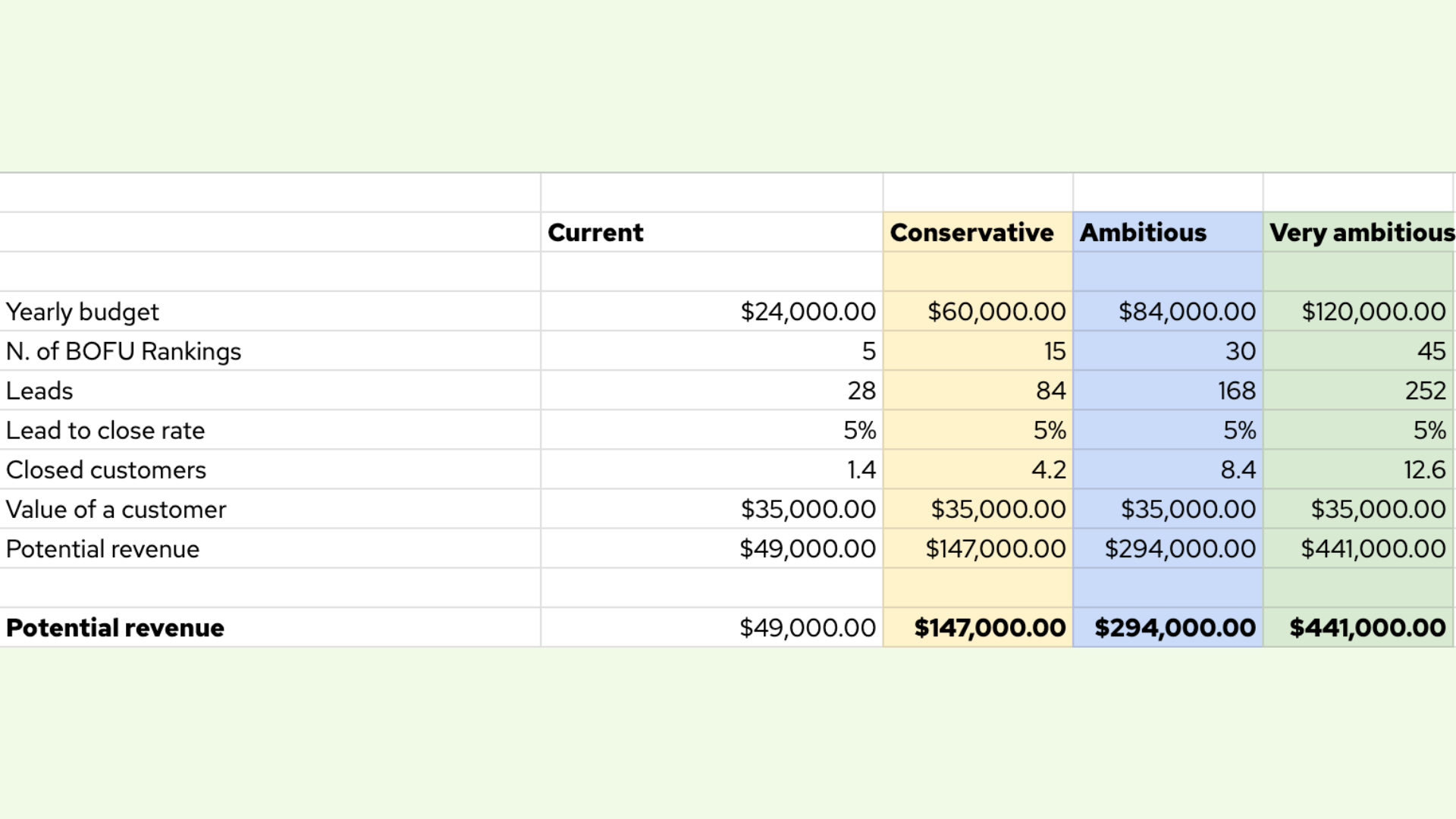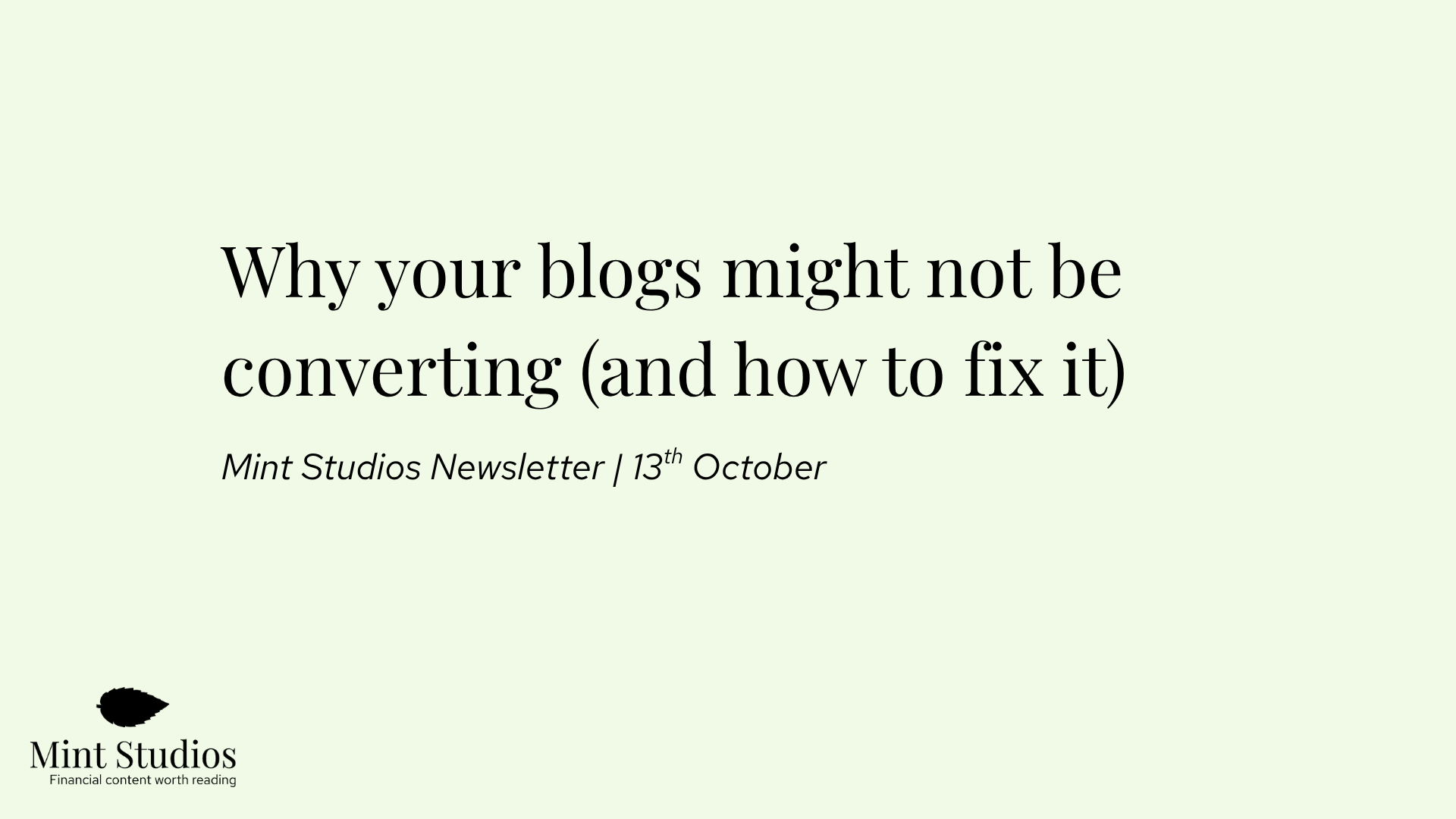“What is the return on our content marketing costs?”
One day, you may get this question from your leadership.
And when they ask this question, what they’re really asking is: Are we getting enough of a return to continue investing in this marketing activity?
Or: If we invest more in content, will we get more results?
As a marketer, ideally you want to be in a position where you can answer this question confidently.
Not only so you don’t look bad in front of leadership, but also so you can get more comfortable asking for more when you need to – whether it’s more budget to hire writers, hire an additional full-time employee or just get more time commitment from your Subject Matter Experts.
However, there’s no denying that making a business case for content marketing isn’t as easy as for PPC, affiliate marketing or even for events.
But the good news is that it’s not impossible. In fact, it’s easier than you think.
As an agency that specialises in helping companies acquire customers with content marketing, we’re constantly building a case for content marketing. So we thought we’d explain how we demonstrate the ROI of content and how you can use these tools to help build a business case for content.
Note: want to get our latest articles in your inbox? Join our newsletter that we send out every 2 weeks!
Why is it hard to build a business case for content marketing?
It's not easy to track the customer journey with content marketing
The main reason it’s hard to build a business case for content is that it’s hard to measure results.
As most digital marketers know, it’s hard to measure the true journey of a customer. If a prospect did research on Google, read an article and then reached out 6 months later, does the piece of content get credit? If a different prospect read your white paper, followed your CEO on LinkedIn and signed up to your newsletter, is that a win for content marketing?
Other marketing channels are simpler. For example, PPC is relatively straightforward: once someone clicks an ad, you can find out what page they converted on, which keyword they typed in, what ad they clicked on and, with the right CRM set-up, whether they became an opportunity and a closed deal. As long as they did all these steps in the last 90 days, you can track the entire customer journey all the way to a sale via Google Ads.
If only content marketing was that easy!
There are three main reasons content marketing is hard to track:
- Google Search Console and your CRM won’t share the exact keyword someone typed in to reach your page and convert. You can only guess this if you have a targeted page targeting a specific keyword. Common content marketing tools like Google Search Console or CRMs don't share the keyword that triggers the start of a specific customer's journey. At best, you can guess at which SEO piece of content helped bring in a lead and possibly drive a sale, which makes it harder to know what does and doesn’t work with your content.
- Most content is focused on the Top of the Funnel (TOFU). Most content that marketers create is focused on raising awareness and on positioning the company as a thought leader. The issue with that is that readers at the Top of the Funnel will rarely convert immediately. That article may have done a great job of raising awareness of your product but didn’t help bring in a sale. Six months later, when the reader is ready to buy, they’ll think of you and type “brand name” – but Google Ads will get the credit, rather than that initial piece of content.
- It’s not as easy to track first-touch attribution. First touch means “What was the first page a user visited on your website before converting?” and is key to tracking content marketing success because it tracks how new users discovered your website (especially important if you do SEO). GA4 used to include this in their dashboard, but have now phased this out. This means you can only get this information if you export the data via BigQuery and set up your own Looker dashboard, or if you set up specific reports in CRMs like HubSpot and Salesforce (and they still don’t make it easy to do).
Content marketing has multiple use cases, making it even harder to attribute results
Another reason it’s hard to build a business case for content is that content serves multiple use cases.
With Google Ads, the main goal is to drive conversions and leads – you’re paying per click, so you want to make sure that click is worth it. That’s not the case with content. Content doesn’t just help with conversions, it also helps raise awareness, educate prospects and current customers, position the company as thought leaders – and much more, all which is also hard to track. Anyone in marketing knows brand awareness is important, but when leadership wants sales, awareness won’t pay the bills. And that’s why the content marketing budget is constantly getting questioned.
Because most content focuses on awareness and education, many marketers track micro-conversions like PDF downloads and newsletters subscribers. These are great to monitor, but ultimately someone who is subscribing to your newsletter isn’t indicating they are ready to buy – they are just interested in reading your content. These conversions rarely lead to sales, which makes it even harder to prove the business results from content.
However, just because it’s hard to build a business case for content marketing, doesn't mean it’s not worth trying. As we’ll see in this article, it’s doable. Once you have the right tracking set up and can finally prove that you’re bringing in sales, your life as a content marketer gets much easier.
There are three elements to making a business case with content marketing:
- Create BOFU content
- Set up the right conversion tracking
- Use the ROI formula
We’ll go into detail of each of these elements.
- Building a business case for content marketing: start with BOFU content
The easiest way to make a business case for content marketing is to start creating content that will help with the last mile of a customer’s journey. This is where a conversion or sale is imminent, and therefore a lot more easily attributable.
The key issue with creating TOFU content focused on educating and building awareness is that it’s going to take time to see results. Sure, you’ll get social shares and newsletter signups, but anyone looking up 'What is Payroll software' isn't ready to buy, and they probably won't be for months or even years to come.
Imagine if we approached content marketing in a similar way that we approach PPC. Instead of creating content focused on building awareness, becoming known as thought leaders, and educating, we create content focusing on converting a person who is ready to buy. Because PPC focuses only on conversions, tracking ROI and making a business case is a lot easier. What if we did the same for content marketing?
In our world, we call this Bottom of the Funnel (BOFU) content.
In other words, creating content that targets people who are already close to converting and are at the bottom of the imaginary marketing funnel and journey.

There’s a lot of benefits to this approach:
- The results from content and SEO can be exponential, and there’s no limit to how far you can go. With PPC, eventually you reach a point where more spend doesn’t equal more sales at the same rate as before. Content is more of a long-term investment, and generally it grows exponentially, meaning you don’t have to keep spending more to grow at the same rate as before.
- Content allows you to go in more depth about certain topics, enabling higher conversion rates. For certain topics, you need to be able to go into more detail and a landing page isn’t enough. For example, articles where you compare your product to competitors.
- Generally, the quality of leads from content are higher. Someone who spends time reading an article and learning about your product is more likely to know if they are a good fit for your product. Which means if they’re not a good fit, they won’t reach out. Those that are a good fit are the ones that reach out, leading to higher lead to close conversion rates and even bigger deals.
So, instead of trying to boil the ocean by constantly focusing on awareness and education (and not being able to prove much), why not start with those prospects who are an easy win and use those to build your business case?
In fact, it’s likely you’re already seeing the difference in results in Top and Bottom of the Funnel already. If you go to your Google Analytics or HubSpot right now and look at which pieces of content bring the highest conversions, you’ll probably see that most conversions are coming from three to five pieces of content.
It’s very likely most of those are going to Bottom of the Funnel. Here’s a screenshot of the top highest converting articles of the past six months for a client of ours (last click attribution only). In total, there were 32 leads. Of those 32, over two thirds come from the top three Bottom of the Funnel articles.

Not only do most of the leads come from BOFU pieces, but what’s also important to note here is the huge difference between TOFU And BOFU content. It isn’t just a couple of conversions. The highest converting BOFU and TOFU in the example above have a difference of five times. I’ll say it again: the highest converting BOFU piece converts five times more than TOFU.
To summarise: by creating BOFU content, you can generate leads and sales with content because you’re targeting people who are a lot closer to converting. Because you’re helping bring in business, it’s a lot easier to build a business case for content marketing because you can actually prove that you’re contributing to growing the company
This is not to say you shouldn’t create content that will help with awareness and education. But the fact is, you won’t be able to create content that helps with brand awareness if your budget or team is completely cut down because you weren’t able to prove that you brought in customers.
As a marketer, BOFU content is an element in your toolkit. It’s a tool to help you bring in more conversions with content, which will then make it a lot easier to build a business case for your entire content marketing. Without BOFU content, all you can hope for is building brand awareness which is more difficult to attribute and can take months or years to see results.
You can learn more about how to create BOFU content here: What is BOFU (Bottom of the Funnel) Content and Why Is it Important?
And how BOFU content helped one payment company generate over $500k in business: Case Study: How We Helped Zai Gain Multiple SQLs Per Month with Content
2. Building a business case for content marketing: get the right conversion tracking in place
Creating BOFU content is a great way to start to bring in attributable conversions and sales.
But all that effort is for nothing if you don’t have the right tracking in place. You cannot report on how many sales you’re generating if you’re not tracking them properly.
Just to reiterate: we don’t want to track newsletter subscribers or PDF downloads. We want to track form submissions, book a demo or free trials. Ideally, these conversion events offer a clear indication that someone is looking to make a buying decision.
How can you track conversions from an article? What’s important here is you don’t just want numbers. You want the actual leads that came through, including the names, company names, enquiry and what their buying journey is like. That way you see not only overall numbers, but the quality of the leads your content is bringing in.
Before we get into the specifics, it’s important to first understand the difference between first and last click attribution, both which are important to track for content. With first click attribution, you’re tracking the first touch point a user had with your website. With last click attribution, you’re tracking the last point a user had before submitting a form or demo.
As a content person, it’s very important you track first click attribution, especially if you invest in SEO. You’ll find that users may discover your website via a blog article, view a few product pages and then convert. One bottom of the funnel article could be the trigger that lands a customer on your website and gets them to convert.
Unfortunately, GA4 doesn’t make it easy to track this, so you’ll have to use a workaround. There are two parts to setting up conversion tracking: GA4 and your CRM.
1. Setting up conversion tracking via GA4
With GA4, you want to make sure you have event tracking in place so that when a reader submits a form, their action fires an event, which you’re tracking in your GA4. This will be last click attribution only, but is still important to track. When the right event is set up, you’ll be able to see via a GA4 report or Exploration the blog articles that lead to a form submission (last click). This is great to get a quick overview of which articles are helping with the last part of a conversion.

2. Setting up conversion tracking via your CRM
The next part is your CRM. With GA4, the data is anonymised so you’ll just only get last click attributed numbers, which is not enough to really make a business case and not enough to get a good understanding of what is and isn’t working with your content.
For example, let’s say blog A brought in two leads each worth $100k, and blog B brought in 4 leads but each worth $25k. Knowing the size of the business opportunities is super valuable information and will help guide you when deciding what kind of content to do more of.
The issue is that GA4 will only show you the numbers two and four. The blog that brought in four leads may look like it performed better, when in actuality it was the one with two leads that brought in higher quality leads.

Being able to see this difference is significant because it can guide your content strategy to replicate better conversion quality, like creating more content on the topic of the blog that brought in just two high value leads.
If your CRM is HubSpot, you can set up a few reports that will allow you to see, at a glance, which blog articles brought in the highest quality leads and deals. You’ll be able to generate our favourite report, which allows you to see at a glance how much revenue your blogs have helped generate:

We’ve written a guide on how to set up this type of HubSpot report here: How to Track the Quality of the Leads Your Content Brings in [With 6 HubSpot Reports]
If your CRM is Salesforce, the only process we’ve found works so far is manually going through leads that have come in organically and seeing the first page they’ve seen, which is less than ideal. Another option is to use a tool like Gated Content that tracks the first page URL and integrates with Salesforce. We’ll update this article if we find an easier workaround for Salesforce.
It may take you a while to get all the events firing correctly, the right permissions access in HubSpot and the reports set up. But it’s incredibly worth it. Having the right conversion tracking in place is what will allow you to know your numbers and speak the language of your leadership: leads and sales.
3. Building a business case for content marketing: calculate the ROI
You’ve now got the fundamentals in place: you’re focusing more on BOFU content to help you get more conversions, which you’re tracking all the way from form submission to deal value thanks to GA4 and your CRM.
The last step is actually being able to measure the ROI and prove your business case.
Calculating ROI: understanding how many leads you need to generate to pay for content marketing costs
Whenever we start working with a client, we’ll do some calculations to be able to answer the question: how many leads do we need to generate to pay for ourselves?
This is a good initial goal to have to prove that content marketing isn’t just money going down the drain and the ROI is positive. Once you reach that goal, you can then work closely with your marketing team to determine what the next goal should be.
We’ll illustrate how we do that first step with an example.
Let’s take a corporate expense tool, called “Oxo”.They help SMBs and enterprise companies with corporate expenses via employee cards, an app, tools, and etc. If they were looking to work with us, we would ask them the following questions:
- How much is one customer worth across one year?
- What is the lead to close rate?
In this made-up example, we’ll say that on average, a customer pays $2k per year to use the tool, and that the lead to close rate is 20%.
Then take the cost of content marketing. This will depend on each company, but we’re going to imagine that Oxo has one in-house content marketer with a salary of $8k / month, plus a freelance writer who charges $2k / month, bringing total monthly costs to $10k.
We can then do a simple calculation (this calculator comes from Grow & Convert’s website).

It’s a very simple calculation. We’re essentially dividing the cost of content marketing by the average annual value of a lead to understand how many leads we need to generate per month to cover our costs across a year. In this case, we need to generate 25 leads per month to cover the cost of content marketing across a year (you can get a copy of the calculator in G&C’s original post).
If Oxo’s content is already generating over 25 leads a month, that’s amazing. Oxo’s content marketer can now go to leadership and show them that the ROI is positive and there is quite likely room to scale.
If the Oxo content team is nowhere close to that, e.g. 0 leads per month, the next question is: can they get to 25 leads? And how long will it take?
Again, the answer to this question depends on a few variables:
- How old the Oxo website is. If it’s very young, then it’ll take a while for SEO to ramp up and get results.
- The competition. If it’s a saturated market, it may be harder to rank on Google which may delay results as well.
- The resources. If they’re using SEO as a distribution channel, how many articles can they publish per month? Will these be in-depth pieces that are BOFU focused? Do they have good writers? For example, if they’re just able to publish one piece per month, that may not be enough to get to the 25 leads per month goal within a year.
- Do they have a proven digital sales funnel that works? It’s important that the company has a sales funnel that works and that they've proven they can convert leads digitally. If they're losing clients along the way due to poor UX or a bad product that they'd need to make a business case for that first before anything else.
In this example, let’s say Oxo’s website has been around for two years, has strong authority and the product has strong product market fit. However, corporate expense management is a competitive market. So 25 leads per month is very doable, but it could take over 6 months to hit that goal. For them, we’d recommend doing a lot of competitor keywords since they have historically been the highest converting articles and, in a more saturated market, people are more likely to be comparing solutions.
This is where strategy is complex and there are a lot of variables, and it’s also why we do a two-week diagnostic when we first work with clients to understand what the opportunity is, before creating content.
Getting a positive ROI from content is just the first step here. To really speak the language of leadership, you then want to be able to try and forecast results and share what may be doable depending on budget.
Forecasting: linking your content marketing budget to an estimated increase in leads, deals and customers
Anyone who works in content knows that trying to forecast and estimate is very difficult because there are so many variables in place, many which cannot be controlled. A lot of content marketing’s success depends on the quality of the content and on the writer understanding the target’s audience pain points. Also, buyer behaviours change over time and content often has to be updated.
This is why it’s so important to keep a forecasting model as simple as possible, and to make it clear that these are just estimates and that there are a lot of variables at play.
If we want to build a basic model with projections, we’ll typically start with something like this:

Although it’s hard to forecast and estimate, this is how you speak the language of leadership and explain the potential for content marketing. Developing a proper model is an advanced level of content marketing and out of the scope of this article (we may do a future article on this).
However, before getting to this it’s important to start with the basics: create BOFU content, get your conversion tracking in place and start generating enough leads/sales that you can prove the ROI.
If you’re doing that, you’re already ahead of 90% of people in content, and are well on your way to making a strong business case for content marketing.
Building a business case with content: create BOFU content, implement conversion tracking and track your ROI
With BOFU content, good conversion tracking and the ROI calculator, you’re in a much stronger place to start building a business case for content marketing.
These are all tools to get more alignment with leadership, speak their language and hopefully, in the long run, get the best results from your content marketing.
Learn more about what we do:











